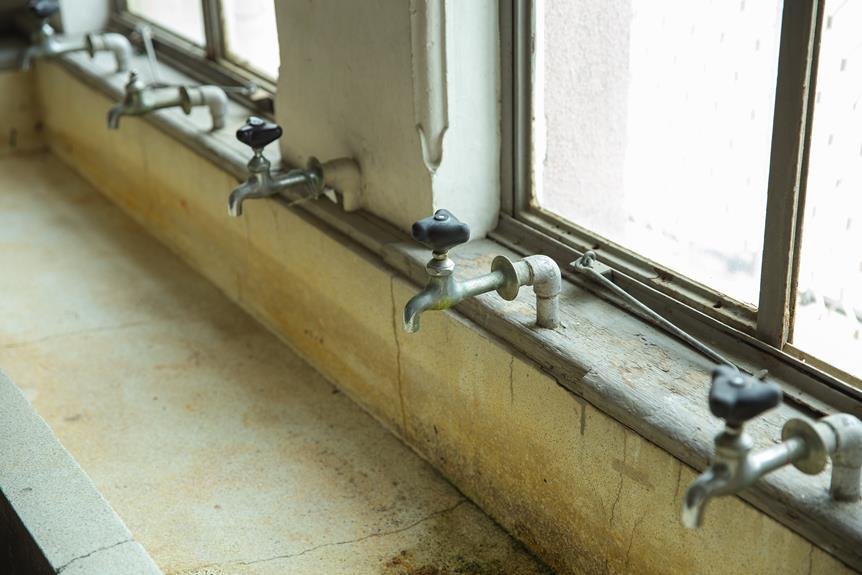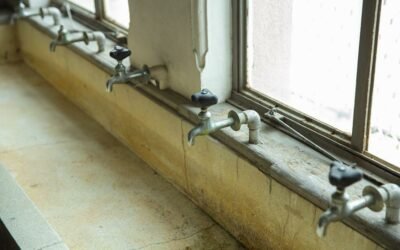Do you ever wonder if mold can grow on metal surfaces?
In this article, we will explore the factors that affect mold growth on metal and how to identify signs of mold infestation.
You will also learn effective methods to prevent mold from growing on metal and how to remove it if it does appear.
Whether you are a homeowner or a professional dealing with mold on metal, this article will provide you with the knowledge you need.
Key Takeaways
- Excessive moisture, poor ventilation, high humidity levels, condensation, and water leaks or flooding are factors that can contribute to mold growth on metal.
- Visible mold patches, musty smell, allergic reactions in individuals, peeling paint or wallpaper, and warping or buckling of metal surfaces are signs of mold infestation on metal.
- Proper ventilation, regular inspection for leaks or moisture sources, controlling humidity levels, promptly addressing water damage or flooding, and applying anti-mold coatings or paints on metal surfaces can help prevent mold growth on metal.
- Scrubbing with a brush, applying vinegar or hydrogen peroxide, using specialized mold removal products, properly disposing of mold-infested materials, and consulting a professional for extensive mold infestations are effective methods for removing mold from metal.
Factors Affecting Mold Growth on Metal
To prevent mold growth on metal, you need to regularly clean and dry the surface.
There are several factors that can affect mold growth on metal surfaces.
One of the main factors is the presence of moisture. Mold requires moisture to grow and thrive, so if the metal surface is constantly exposed to moisture, it becomes more susceptible to mold growth. This can be a result of high humidity levels in the environment or water leaks in the vicinity.
Another factor is the presence of organic matter on the metal surface. Mold feeds on organic materials such as dust, dirt, and oils. If these substances are present on the metal surface, they can provide a food source for mold spores to grow.
Additionally, the temperature of the environment can also play a role in mold growth. Mold tends to thrive in warm and humid conditions, so if the metal surface is exposed to such conditions, it becomes more susceptible to mold growth.
Finally, the ventilation and air circulation around the metal surface can also impact mold growth. Poor ventilation can create stagnant air, which can promote mold growth. Therefore, it's crucial to ensure proper air circulation around the metal surface to prevent mold growth.
Signs of Mold Infestation on Metal
You may occasionally notice signs of mold infestation on metal surfaces. Mold can grow on metal when conditions are favorable, such as high humidity, moisture, and organic matter present on the surface. It is important to identify these signs early to prevent further damage and potential health risks.
Here are some common signs of mold infestation on metal:
| Signs | Description |
|---|---|
| Discoloration | Mold growth can cause discoloration on the metal surface, appearing as black, green, or brown. |
| Musty Odor | A strong, musty smell emanating from the metal indicates the presence of mold. |
| Texture Changes | Mold may create a fuzzy or slimy texture on the metal, making it feel rough or slippery. |
If you notice any of these signs, it is crucial to take immediate action to prevent further mold growth. Start by cleaning the affected area using appropriate cleaning agents and techniques. It is recommended to wear protective gear, such as gloves and a mask, to minimize exposure to mold spores. Additionally, addressing the underlying cause of moisture or humidity is essential to prevent future mold infestations.
Preventing Mold Growth on Metal Surfaces
Prevent mold growth on metal surfaces by implementing effective preventive measures. Mold growth on metal can lead to structural damage, corrosion, and potential health hazards. To ensure the longevity and safety of metal surfaces, it's crucial to follow these preventive steps.
Firstly, maintain proper ventilation in areas where metal surfaces are present. Proper airflow helps to reduce moisture levels, which are conducive to mold growth. Ensure that ventilation systems are regularly inspected and maintained to prevent any blockages or malfunctions.
Secondly, control humidity levels. High humidity promotes mold growth, so it's essential to keep humidity levels below 50% in metal environments. Consider using dehumidifiers or air conditioners to regulate humidity and prevent excessive moisture accumulation.
Regular cleaning is also crucial in preventing mold growth on metal surfaces. Clean metal surfaces using a mild detergent and water solution regularly. Pay close attention to areas prone to moisture buildup, such as corners, crevices, and joints. Dry the surfaces thoroughly after cleaning to minimize moisture levels.
Additionally, it's important to address any leaks or water damage promptly. Inspect metal surfaces for signs of leaks or moisture intrusion and repair them immediately. Prompt action can prevent mold growth and further damage.
Removing Mold From Metal
When mold does grow on metal surfaces, it can be effectively removed using proper cleaning techniques. Mold on metal can not only cause structural damage but also pose health risks. Therefore, it is crucial to address and eliminate mold growth promptly. Here are some recommended cleaning techniques to remove mold from metal:
| Cleaning Technique | Steps |
|---|---|
| Scrubbing with a brush | 1. Mix a solution of water and detergent. |
| 2. Dip a stiff-bristle brush into the solution. | |
| 3. Scrub the affected metal surface vigorously, focusing on the mold-infested areas. | |
| 4. Rinse the metal thoroughly with clean water to remove any remaining mold spores. | |
| 5. Dry the metal completely using a clean towel or allow it to air dry. | |
| 6. Inspect the metal to ensure all mold has been removed. Repeat the process if necessary. | |
| Applying vinegar or hydrogen peroxide | 1. Dilute vinegar or hydrogen peroxide with water in a 1:1 ratio. |
| 2. Apply the solution onto the moldy areas using a spray bottle or sponge. | |
| 3. Allow the solution to sit on the metal for about 15 minutes. | |
| 4. Scrub the surface with a brush to remove the mold. | |
| 5. Rinse the metal thoroughly with clean water. | |
| 6. Dry the metal completely. |
It is essential to note that these cleaning techniques may vary depending on the type of metal and severity of the mold growth. It is recommended to wear protective gear, such as gloves and a mask, while cleaning mold from metal surfaces. If the mold infestation is extensive or persists despite cleaning, it is advisable to consult a professional mold remediation specialist to ensure proper and thorough removal. By addressing mold growth promptly and employing appropriate cleaning techniques, you can effectively remove mold from metal surfaces and prevent further damage.
Professional Help for Mold on Metal
To effectively address mold growth on metal surfaces, it may be necessary to seek professional assistance. Mold on metal can be particularly challenging to remove, as the spores can penetrate deep into the surface and establish themselves. Professionals who specialize in mold remediation have the knowledge, experience, and equipment to effectively tackle this problem.
When you hire a professional to handle mold on metal, they'll first assess the extent of the mold growth and determine the best course of action. This may involve conducting tests to identify the type of mold present and its potential health risks. Based on their findings, they'll develop a customized plan to remove the mold and prevent further growth.
One common method used by professionals is abrasive cleaning. This involves using specialized tools and techniques to physically remove the mold from the metal surface. In some cases, they may also apply antimicrobial solutions to kill any remaining mold spores and inhibit future growth.
It is important to note that mold growth on metal can be an indication of a larger issue, such as excessive moisture or poor ventilation. Professionals can also help identify and address these underlying causes to prevent future mold problems.
Conclusion
In conclusion, mold can grow on metal surfaces under certain conditions. Factors such as moisture, temperature, and organic matter can contribute to mold infestation on metal.
It's important to be aware of signs of mold growth on metal, such as discoloration or a musty odor. Taking preventive measures, such as keeping metal surfaces dry and clean, can help avoid mold growth.
If mold is already present, it's advisable to seek professional help for effective removal.






0 Comments